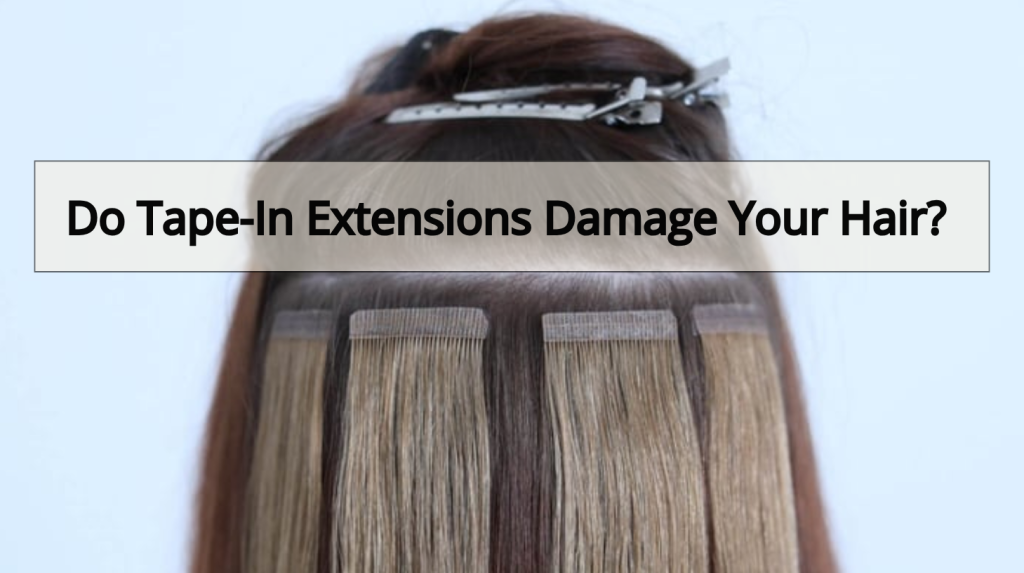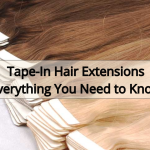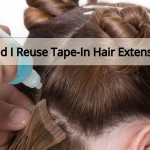Hair Knowledge
Do Tape-In Extensions Damage Your Hair? The Truth for Salon Professionals and Clients
As tape-in extensions grow in popularity across Europe—especially in premium salons—the question of safety often comes up: “Will tape-in damage my natural hair?” This concern is valid. While tape-ins are known for being lightweight, discreet, and semi-permanent, poor application or improper care can lead to breakage, scalp irritation, or hair thinning. In this guide, we explain how tape-in extensions work, what can cause damage, and how both salon professionals and clients can use them safely.
I. Understanding Tape-In Extensions and How They Work
Tape-in hair extensions are thin wefts of human hair pre-attached with medical-grade adhesive tape. During installation, these wefts are applied in a “sandwich” method—one weft placed above and one below a section of the client’s natural hair. Because of their flat, flexible structure, tape-ins lay close to the scalp and distribute weight evenly. This makes them one of the least invasive and most comfortable methods for semi-permanent wear.
Find out what you need to know about Tape-In Hair Extensions
II. Can Tape-In Extensions Damage Your Hair?
The short answer is: Tape-in hair extensions are safe—if used and maintained properly.
But just like any beauty service, the result depends heavily on technique, tools, and care routines. Let’s break down the most common causes of damage and how to prevent them.
✅ When Tape-In Are Safe and Hair-Friendly
Tape-in extensions are designed with comfort and hair health in mind. Here’s when they’re considered a low-risk solution:
- Flat and flexible design: Tape-ins lie flat against the scalp, reducing stress on hair roots. Unlike heavier methods like sew-ins or keratin bonds, tape-ins won’t tug on the hair shaft if installed correctly.
- Even weight distribution: When applied properly, tape-ins distribute weight across a larger section of hair, avoiding concentrated tension at the roots.
- No heat or glue required for installation: Tape-ins use medical-grade adhesive instead of heat tools or bonding glue, which lowers the risk of thermal damage.
- Quick and clean removal process: With the right remover, the extensions can be taken out without tugging or breakage—preserving the integrity of your client’s natural hair.
- Reusable and repositionable: Unlike one-time methods, tape-in extensions can be safely reapplied multiple times, minimizing both waste and wear on natural strands.
⚠️ When Tape-In May Cause Damage Your Hair
On the flip side, tape-in extensions can become harmful under these conditions:
Incorrect application
- Applying the tapes too close to the scalp may restrict natural movement, leading to tension or even traction alopecia over time.
- Using too little hair in each “sandwich” may cause the weight of the extension to pull directly on the root.
Improper removal
- Pulling out extensions without the proper alcohol- or oil-based remover can rip hair from the scalp.
- Rushing through removal or using too much force weakens natural hair and irritates the skin.
Wrong products near the tape area
- Oils, conditioners, or silicone-heavy products near the bond can break down adhesive and cause slippage.
- Sulfate shampoos may also weaken the bond and dry out the natural hair shaft, making it more vulnerable to breakage.
Poor maintenance
- Skipping regular maintenance sessions (every 6–8 weeks) can cause tangling at the root, product buildup, and matting.
- Brushing while wet or sleeping with damp hair may increase stress on bonds and roots.
Inexperienced application
- DIY application without sectioning skills or training can lead to uneven tension, tape visibility, or even bald patches.
📌 Common Signs of Damage from Tape-Ins (and What They Mean)
| Sign | Possible Cause | How to Fix |
|---|---|---|
| Hair feels sore near roots | Tape placed too close or too tight | Reinstall with 0.5–1 cm spacing from scalp |
| Tapes sliding or falling | Oil/silicone product near roots | Use extension-safe, lightweight haircare |
| Hair thinning after removal | Removal done too fast or too rough | Always use tape remover + gentle detangling |
| Tangling near scalp | Overdue for move-up | Reposition every 6–8 weeks at salon |
In short, tape-in extensions damage your hair only if people skip professional techniques and proper care.
A professionally applied, well-maintained set of tape-ins should never leave you with bald spots, breakage, or discomfort. In fact, many users report healthier hair after switching from glue or heat-based extensions to tape-ins.
III. Risk Factors: Who Should Be More Cautious?
Tape-in hair extensions are generally safe and low-maintenance when applied by professionals. However, they may not be suitable for every client. Understanding individual hair and scalp conditions is essential before recommending tape-ins in your salon.
Let’s explore the most common risk profiles and how to manage them effectively:
⚠️ 1. Clients with Very Oily Scalps
Natural oil (sebum) produced by the scalp can weaken the adhesive over time, leading to slippage or premature tape detachment.
Symptoms to look for:
- Tapes shifting within 2–3 weeks
- Visible residue near the roots
- Difficulty keeping the tapes in place
Salon recommendation:
- Use strong-hold, oil-resistant medical tape
- Advise washing the hair with a clarifying shampoo 24 hours before installation
- Schedule more frequent maintenance appointments (every 4–5 weeks)
⚠️ 2. Clients with Extremely Fine, Fragile, or Damaged Hair
If the client has breakage-prone strands, weak roots, or thinning hair due to past chemical treatments or health issues, tape-ins could add unnecessary weight and stress.
Potential risks:
- Excessive shedding around the tape area
- Tension alopecia from poorly distributed weight
- Breakage during removal
Salon recommendation:
- Use invisible tape-ins or single-sided tape for lighter application
- Reduce the number of tape sandwiches in each section
- Perform a strand test before full installation
⚠️ 3. Clients with Scalp Sensitivities or Allergies
Some individuals have allergic reactions to adhesives or experience itching and discomfort under the tapes, even when applied correctly.
Red flags:
- Itchy or inflamed scalp within the first few days
- Redness around the taped areas
- History of contact dermatitis
Salon recommendation:
- Use hypoallergenic or medical-grade adhesive only
- Perform a patch test 48 hours before appointment
- Consider alternative extension types like clip-ins or halo hair for sensitive scalps
⚠️ 4. Athletes and Clients with High Activity Levels
Sweat, chlorine, saltwater, and frequent washing can all reduce the longevity of tape-in bonds.
Problems that may arise:
- Tapes loosening after workouts
- Moisture buildup causing odor or mildew
- Reduced wear time (4 weeks instead of 6–8)
Salon recommendation:
- Educate the client about protective hairstyles and sweatbands
- Suggest dry shampoo for post-workout care
- Recommend temporary extension types (clip-ins or ponytail extensions) if sweating is daily
⚠️ 5. First-Time Users or DIY Installers
While tape-ins may seem simple, first-time users often underestimate the precision and care required for proper application and maintenance.
What can go wrong:
- Crooked placement leads to visibility
- Poor sectioning causes uneven weight distribution
- Incorrect removal leads to root breakage
Salon recommendation:
- Offer a first-time consultation and full education before application
- Provide a step-by-step care guide after service
- Encourage professional reapplication every cycle (6–8 weeks)
💡 Pro Tip for Stylists:
Create a simple “Tape-In Suitability Checklist” during consultations, asking about:
- Hair history (chemical processing, breakage, shedding)
- Scalp condition (oily, sensitive, normal)
- Lifestyle (exercise, swimming, daily styling habits)
- Expectations (volume, length, natural blending)
This helps ensure you choose the right extension method for every individual—and minimizes any risk of dissatisfaction or damage.
V. Salon Best Practices to Prevent Damage
If you’re a salon owner or stylist, these technical practices can ensure safe, long-term use of tape-ins:
🛠️ Application:
- Use medical-grade tape only (avoid industrial adhesives).
- Section precisely and apply with gentle tension.
- Never apply tape on damp hair or oily roots.
✂️ Maintenance:
- Recommend follow-up every 6–8 weeks.
- Educate clients on proper at-home care.
- Use salon-grade removers and re-tape safely.
💡 Tip: Offer a consultation session before the first application to assess the client’s hair condition and manage expectations.
IV. Tape-in Aftercare to Minimize Risks
Educate your clients on basic daily habits to keep tape-ins healthy and damage-free:
- Brushing: Use a loop or extension brush. Start from the ends and work upward.
- Washing: Use sulfate-free, lightweight shampoos. Avoid oil-based products at the roots.
- Sleeping: Tie hair in a loose braid or ponytail to prevent tangling.
- Drying: Always dry the roots thoroughly—never leave the tapes wet.
Encouraging good habits is the best form of damage prevention.
V. Final Thoughts
So, do tape-in extensions damage your hair? No—if done right. The key lies in proper technique, realistic expectations, and responsible aftercare. When applied and maintained professionally, tape-ins can actually be a safer alternative to other methods like hot fusion or sew-in extensions.
At N Hair Factory, we supply premium-quality tape-in hair extensions made from 100% Remy and Virgin human hair, designed to blend naturally and stay secure without stressing your client’s scalp.
✅ Safe. Lightweight. Salon-Approved.
Choose tape-ins you can trust—for both your business and your clients.
Related Article
Tape-In Hair Extensions: Everything You Need to Know
How Long Do Tape In Extensions Last?





